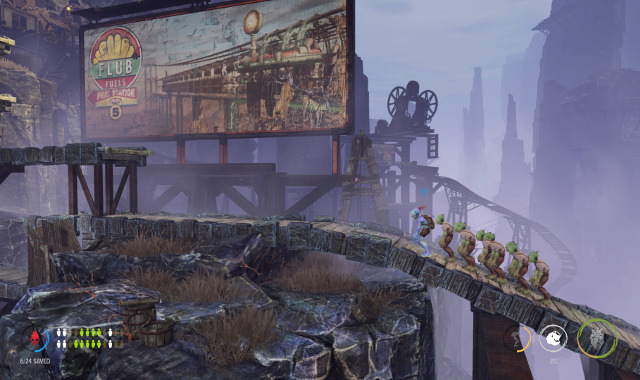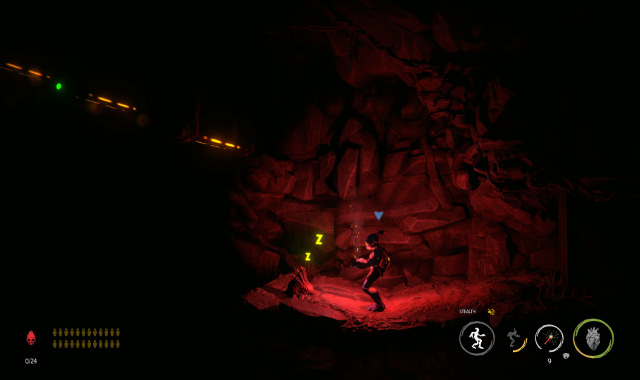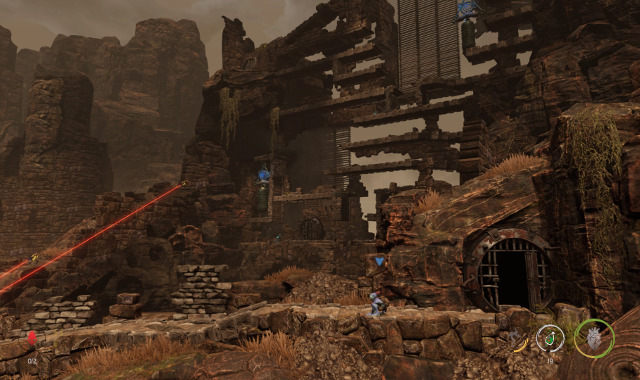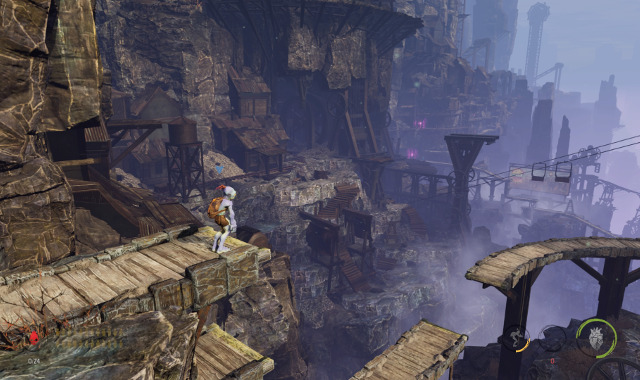After 2014’s Oddworld: New ‘n’ Tasty remade Oddworld: Abe’s Oddysey for modern hardware, Oddworld: Soulstorm gives the same treatment to Oddworld: Abe’s Exoddus. On the surface, this bright, colorful re-imagining is the same but more, an exuberant platformer full of the same chaotic energy Abe’s known for. Unfortunately, looking the part is about all it’s good for.
Oddworld: Soulstorm is a buggy, shallow remake that does away with much of the idiosyncrasies that made those early Abe games so memorable. Instead, we have lavish scale, and lots of numbers and collecting, as a way to try and cover up for nostalgia that’s just going through the motions, and poorly at that.
It’s not good, and at best, it serves as an indictment of the worst habits of big-budget video games in the current era.
Oddworld: Soulstorm Review — Revolution By Numbers
My time with Oddworld: Soulstorm started off well enough.
An early set-piece involves trying to protect hundreds of escaping Mudokons from the gunfire of onlooking Sligs. You must possess one of the armed guards and use them to provide covering fire, killing the others in the process. After a few tries, I settled on making peace with the nine Mudokons I’d lost and progressing without them, vowing to come back later for a perfect score.
It’s the tonal whiplash of this section that took me by surprise. After some relatively simple puzzles, Soulstorm suddenly placed many dozens of lives in my hands. The introduction saw Abe learning that the rebellion he’d started at Rupture Farms was just the beginning, and that the rest of his people needed him to lead them further. This was the game telling me to take that responsibility seriously. Or, at least, that’s what I thought.
But as I moved forward, I learned these moments are few and far between, and the rest is mostly just rummaging through bins and lockers, throwing smoke bombs, and hoping the Slig that’s just stopped hasn’t glitched in place. For every sliver of satisfaction found in Soulstorm, from managing to get every Mudokon in an area to a portal or working out the exact timing for a gauntlet of enemies, there are hours of working around unpredictable AI and watching meaningless rewards pile up.
Sections are best when they’re basic. If it’s just Abe, an assortment of platforms and obstacles, and some patrolling Sligs, this is the Oddworld you remember. Tip-toeing around, finding ways to hide, cursing yourself for running instead of walking, or vice versa. Any mistake is likely to cost you an attempt, and that tension is still a powerful engine.
Loud and Broken

Oddworld Inhabitants did learn a thing or two from Just Add Water’s work on New ‘n’ Tasty. In particular, the controls are better, especially mapping running and sneaking to two separate shoulder buttons rather than a thumbstick. But that sleekness is absent elsewhere.
When encounters pile-up, with environmental factors or Mudokons, things go awry quickly. Mortars in one stage are an absolute nuisance. The noise from the bombs put the Sligs on high-alert over and over, as if they’d heard Abe, and getting past them meant throwing caution to the wind, less I be trapped by one that won’t calm down long enough for me to sneak by.
Afterwards, the explosion had me pinned down at a checkpoint, the fantastical adventure unwittingly becoming some lukewarm simulation of active fire in war.
Situations get worse when you’ve a band of Mudokons behind you. For portions, you heal them. For others, you convince them to discard their hard hats for a better life. Choices are made in the depiction of your brethren. They all have the same thick American accent, and telling them to stop gives you a ream of “Why are we stopping?” that the game mercifully decides your antagonists never hear.
They’re meant to follow your movements, meaning they sneak if you’re sneaking, run if you’re running, and jump into available lockers if you jump into one. For one or two, this goes off without a hitch, for more, at least one outlier is regular. I restarted many times due to an ignored command to hide, or someone hanging behind the pack on the other side of a gap.
Saving them all requires patience for more than just the obstacles you can see. They can’t follow you up ladders and certain jumps are too large. I was heartbroken when I was forced to leave three behind because a Slig scared away the birds that spawn their nearest portal. Two alternate getaways were available, but they just stood in place at the edge of a jump for either, arbitrarily unable to take advantage.
I don’t know if this was a glitch or not, but it speaks to the way Abe’s revolution has been commodified. The first two Oddworld games are strange in ways that very much reflect the experimentation that produced them. Oddworld Inhabitants was founded on the burgeoning explosion in 3D games caused by PlayStation, co-founder Lorne Lanning coming from a film effects background rightfully believing this was where the money for weird 3D animation was going to come from.
Faded Memories

Both Oddysey and Exoddus are grimy, unforgiving games full of little details and decisions that couldn’t be found anywhere else at the time they released. For many, their first impression was learning Abe’s talking commands from the main menu, his huge round eyes staring at them as they made him fart over and over. They guided him from those awkward conversations to commanding everyone to freedom.
Every screen had to be scanned meticulously before taking a step, and save points were much less common. Finishing those games takes nerves of steel, and ultimately only one thing matters – saving every single Mudokon.
In Soulstorm, you get points for almost everything Abe touches. Bins, crates, secret areas — hitting square and having a look will almost always give a point towards something. This isn’t an Ubisoft sandbox, but it’s just as full of artificial ways to try and make you feel like exploration matters. It’s unnecessary, because yes, I am checking every bin, because I do need the crafting materials, because I want to save everyone.
That this isn’t reward enough is plain cynical. Ironically, at a time when overthrowing corporate overlords is more prevalent in the public conscience than at Abe’s debut, he’s jumping through corporate hoops for a sliver of your sentimentality.
Occasionally, the more survivalist Abe comes through, where you’ve to rely purely on your wits, in caves where there’s very little light, you’re using rocks to defend yourself, and wild hounds are sleeping. Curing the sick in these mines, and then coordinating their journey to safety, is Soulstorm at its most riveting.
In one desperate plea, I threw myself at the snoozing dogs to make them follow me to the other end of the trail to clear the way to the portal. It worked, and I needed a minute after to compose myself. Soulstorm is too concerned about giving platinum medals for dumpster-diving for that investment to last.
To be fair, it is beautiful. The camera holds on Abe through the winding levels, moving in and out of oblique angles to show the sheer size and depth of the world you’re trying to get away from. Sometimes, the perspective settles on an eyesore, some glorious vista that lays beyond Abe’s track. Usually, I’ll grab a screenshot and revel in the atmosphere. I wish these moments were surrounded by a better game.
Oddworld: Soulstorm Review —The Bottom Line

Pros
- Visually pleasing
- Good controls
Cons
- Poor AI
- Lots of bugs
- Unnecessary amount of collectibles
- Not enough tension
As a free PS Plus game, Oddworld: Soulstorm warrants some curiosity, but little beyond that. The regular checkpoints make it easy to play in quick chunks that lessen the likelihood of encountering something glitchy.
Longer sessions tend to be frustrating. It’s a pity Oddworld: Abe’s Exoddus is only on PS3, for the time-being, as this does make a revisit appealing. At least those Sligs are less prone to malfunction.
[Note: The PlayStation Plus version of Oddworld: Soulstorm was used for this review.]










Published: Apr 12, 2021 05:26 pm